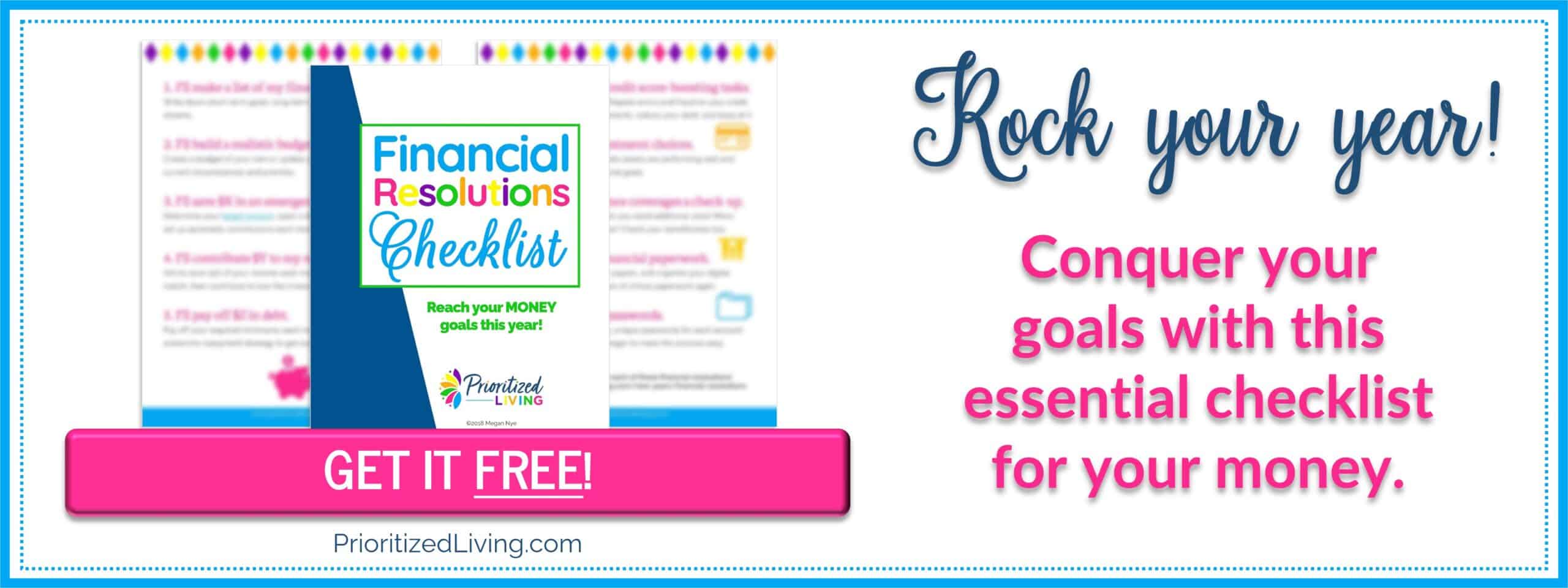The start of a new year is the perfect time to set your goals and make some important resolutions. But you don’t need to wait for January to focus on your finances!
No matter what month it is, the perfect time to make those new year’s financial resolutions is actually now!
So you want to make progress on your financial goals? Get a handle on your spending and debt? Save for the important things? Clean up your credit? Master your money?
This year, make these 10 all-important financial resolutions to maximize your financial health.
1. I’ll make a written list of my financial goals.
Yes, the written part makes a difference! Research shows that people who write down their goals are 50% more likely to accomplish those goals than people who did not physically write them down.
And what kinds of financial goals should you consider writing down? All of them!
Start with the big, long-term goals — funding your dream retirement, covering your kids’ education costs, buying a house, etc. Then add in the shorter-term objectives. Maybe that’s taking a vacation this summer or paying off your car loan next year.
Finally, take the time to brainstorm all your financial dreams. What do you want your money to do for you now . . . in a few years from now . . . or decades in the future? Jot it all down.
Then nail down the specifics of each goal by following these steps to clarify your list.
2. I’ll build a realistic budget.
Now that you have your list of goals, you’ll want the action plan to make them happen. And that’s where your budget comes in.
Creating a budget is essential in plotting your course.

With a solid budget in hand, you know what income you’re starting with. You see clearly what your fixed expenses look like. And you get to choose how you’ll spend discretionary cash each month.
Got a budget already? Take the time each year to review and update that plan. Life changes — even year to year. So you’ll want to ensure your budget reflects your current income, expenses, and priorities.
3. I’ll save $X in an emergency fund.
If your emergency fund isn’t sitting at its target level, filling that deficit should be top priority.
How much should you have? Start by determining your target number.
The goal with an emergency fund is two-fold:
- First, make sure you have enough saved to keep you afloat during a true emergency.
- Second, ensure that the target you choose is a figure that makes you feel secure.
If you have nothing saved right now, start by opening a savings account specifically for holding your emergency fund. Then, set up automatic deposits to that account. I recommend contributing a fixed amount every payday.
If you already have a fund in place — but it’s looking a little light — set up those same automatic transfers. Aim to keep saving until you reach your desired target.
And be sure to double-check that target amount each year. You may need to adjust as your family grows, jobs change, expenses shift, and more.
4. I’ll contribute $Y to my retirement savings.
As a general rule, aim to save 15% of your pre-tax earnings each year toward your retirement.
If you’re not already saving for retirement, explore the options available to you. Look into your employer’s 401(k) plan, a Roth IRA, and a traditional IRA. And familiarize yourself with how each one works.

Step 1: Grab all of your employer’s match.
If your job offers a retirement contribution match, that is free money . . . grab it!
For instance, suppose your company will contribute up to 4% of your salary to your retirement plan if you contribute at least 8% yourself. Set up the 8% contribution on your end to capture the maximum match you can.
Step 2: Opt for low-fee investments in a Roth IRA.
Believe it or not, fees can make a massive difference in your portfolio by the time you reach retirement! Instead of stashing all your cash in your company’s retirement plan, turn to a Roth IRA. It likely offers thousands more options for investments — many with much lower expense ratios.
If you don’t qualify for a Roth IRA, consider contributing to an IRA instead and converting to a Roth IRA after the fact.
5. I’ll pay off $Z in debt.
There are two main types of debt repayment.
First, you have your required payment amount. That’s the minimum payment you owe on each of your loans, credit cards, and lines of credit every month.
Paying that required amount is critical. If you miss even one payment, you could see a major drop in your credit score, get slapped with high fees, pay unnecessary interest, and even risk the loss of your account or collateral.
The second type of debt repayment is the optional one. If you so choose, you can add extra money to your required monthly minimums and pay off your debt faster.
The advantages of accelerated debt repayment are significant — less time in debt, less money owed on interest, a higher credit score, and more available cash to fund your financial dreams.
How you make those extra payments can make all the difference. Fortunately, the math and the leg work have been done for you and refined into a proven debt repayment strategy. I highly recommend the debt avalanche method for maximizing the benefit of those additional payments.
6. I’ll tackle a list of credit score-boosting tasks.
Amping up your credit score can have a surprisingly widespread impact on your life.
And increasing your score may be easier than you think:
1. Erase damaging errors from your credit score.
Pull up your three free credit history reports and pore over each one.
Is your personal information all correct? Do you recognize each account? Do you see any errors?
One in three Americans has at least one error on their credit report. And identity theft is on the rise. So if something in your report looks off, contact the reporting agency immediately to dispute the error. Erasing an error could wind up increasing your credit score.
2. Identify the weak spots in your credit history.
Maximize your efforts at boosting your score by identifying the highest-impact problems.

Check out the details of that process here!
Remember: The number one thing that can make or break your credit score is your payment history. How consistent are you when it comes to paying your bills on time?
If you struggle to remember the due dates for your bills, make the process fool-proof. Set up recurring bank transfers to each of your creditors, so you’ll never be late again.
7. I’ll review my investment choices.
Run down a list of these questions and any others that make sense for your circumstances:
- How satisfied are you with the make-up of your current portfolio?
- Do your investment choices align with your current financial goals?
- Do the assets in your portfolio fit with your current level of risk tolerance?
- Does the choice of those assets make sense, given the current state of the market?
- Does it make sense to incorporate a different type of investment (index funds, ETFs, bonds, etc.)?
- How have your investments been performing over the past few years?
- Are the expense ratios for your assets too high?
- Is it time to rebalance your portfolio to stay in alignment with your target portfolio?
8. I’ll give my insurance coverages a check-up.
Your insurance needs change often — as you age, as your family changes, when you move, when your financial goals shift, and more. So conduct a thorough review of your personal insurance landscape as it currently stands:
- What types of insurance do you currently have? (Do you have medical, dental, vision, short-term disability, long-term disability, long-term care insurance, life insurance, homeowner’s, renters, auto, etc.?)
- Does it make sense to keep the coverages you have?
- Should you buy a policy for a type of insurance you don’t currently have?
- Do you have enough coverage on your existing policies?
- Are you paying too much for your insurance?
- Should you raise or lower your deductibles?
- Do you need to add or remove covered family members from your insurance policies?
- Are your beneficiaries current on your insurance?
9. I’ll organize my financial paperwork.
Missing financial papers can be a nightmare. It mucks up the process when you go to file taxes, apply for a loan, or look up an old record.

You can get a filing cabinet if you wish, or simply buy a sturdy and portable file storage box. Add some hanging file folders, sort your paperwork, and file. Done!
Likewise, set up a digital filing system for your non-physical records. Create folders and subfolders to keep documents organized. Save digital files, and consider scanning important physical documents as well.
Be sure to set up a schedule for backing up those computer drives, so you never put your records at risk.
10. I’ll set up secure passwords.
How do passwords fit in with your financial health? Compromised passwords can expose private account information, reveal sensitive personal details, and allow bad actors to hack your accounts or steal your identity.

Of course, keeping track of all those strings of letters, numbers, and characters is the real trouble. I strongly recommend using a password manager. (LastPass works wonders for my family.)
With a solid password manager, your private information is securely stored with strong encryption. You can easily save and safely access your passwords on any device. You can generate those coveted, unique, strong passwords for all of your accounts.
And LastPass lets you share select account information, so you and your spouse can each access your bank account — or your Netflix queue.
The next 12 months are full of possibility and potential when it comes to mastering your money. Adopt these 10 powerful financial resolutions, and see how far you can go this new year!
What are your most important new year’s financial resolutions?








Leave a Reply